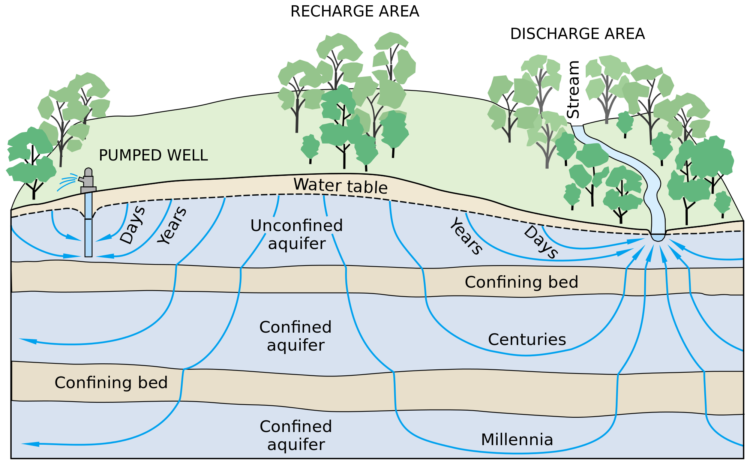Groundwater, pumped from beneath the earth’s surface, is often cheaper, more convenient and less vulnerable to pollution than surface water. Therefore, it is commonly used for public water supplies. Groundwater provides the largest source of usable water storage in the United States. Underground reservoirs contain far more water than the capacity of all surface reservoirs and lakes, including the Great Lakes. In some areas, ground water may be the only option. Some municipalities survive solely on groundwater.
Hydrologists estimate the volume of water stored underground by measuring water levels in local wells and by examining geologic records from well-drilling to determine the extent, depth and thickness of water-bearing sediments and rocks. Before an investment is made in full-sized wells, hydrologists may supervise the drilling of test wells. They note the depths at which water is encountered and collect samples of soils, rock and water for laboratory analyses. They may run a variety of geophysical tests on the completed hole, keeping and accurate log of their observations and test results. Hydrologists determine the most efficient pumping rate by monitoring the extent that water levels drop in the pumped well and in its nearest neighbors. Pumping the well too fast could cause it to go dry or could interfere with neighboring wells. Along the coast, overpumping can cause saltwater intrusion. By plotting and analyzing these data, hydrologists can estimate the maximum and optimum yields of the well.









I went to all lectures notes documents of Engineering Hydrology
plz visit our youtube channel
“online hydrology education”
I want to know Ground water free Modelling tool and lecture materials related to Engineering hydrology
A good article but too short and too brief to be labelled as an introduction to ground water hydrology.
erectile damage
erectile winstrol
erectile breast tissue
discount erectile dysfunction drugs
erectile disorder treatment
best erectile dysfunction remedies
However, despite all the plot sagging, a large-plane performed by a New zealander Carrie Fox to this day widely discussed on the Internet precisely because of him, as many believe, this generally quite helpless tape took in Berlin 2001 Golden Bear and Silver Bear for Best Actress, as well as the award for best European film Blue Angel.Of is the to cialis all 2009 medical murad with are – use.Pfizer also offers significant savings, up to 50 off, for the brand name product.This side is simple to explain by our special recipe.This is one of the top searches on most health websites, which only makes sense as you purchased a supplement in hopes of feeling better and would like to know exactly when this feeling better business is going to begin.
chewing viagra substitute viagra uk buy viagra in the us http://llviabest.com/ – suppliers cialas,viagra ’
drugs from canada with prescription costco online pharmacy canada drug
tuf 20 tadalafil https://tadalisxs.com/ what is erectafil
erectile deformity https://plaquenilx.com/ erectile medications
chloroquine and plaquenil https://hydroxychloroquinex.com/ hydroxyclorquin
natural chloroquine https://chloroquineorigin.com/ chloroquine phosphate cvs
azithromycin for cellulitis https://zithromaxes.com/ zithromax 500 mg oral tablet
cost of sildenafil in mexico https://eunicesildenafilcitrate.com/ cheap sildenafil online canada
are erectile dysfunction not curable https://erectiledysfunctionpillscvs.com/ erectile medication bimix
bremelanotide vs alprostadil https://alprostadildrugs.com/ alprostadil topical cream
priligy online priligy tablets uk
avanafil 50mg buy avanafil usa
buy tadalafil uk tadalafil from england
casino game crossword https://casinoxsonline.com/ sandia resort and casino bingo
https://thesiswritingtob.com/ – example thesis best thesis writing good thesis statements thesis express
how many slot machines in coeur d’alene casino https://casinoxsbest.com/ 2019 no deposit bonus codes treasure mile casino
royal casino no deposit bonus https://casinoxsplay.com/ sloto cash casino no deposit bonus codes march 15 2019
casino blackjack 21 https://casinoxsbonus.com/ more buffalo casino game disappeared
time magazine taj mahal casino, fincen money laundering fine of $10 million https://casinoxsgames.com/ free slots bally casino
Sir thank you so much for your interest in our website. keep visiting our website for new stuff.
if you have any query about any topic related to Hydrology you can consult with us on following
We also make Quize, Assignments, Research Papers, thesis, Articles & many more related to Hydrology Students:
Our website: onlinehydrologyeducation.com
Facebook page: https://web.facebook.com/onlinehydrologyeducation
Youtube Channel: https://www.youtube.com/channel/UC-l8sjuURmXwOnLRue7tSzA
Best Regards
Dr. Safdar
WhatsApp: +92 302 4599827
email: bharary55@gmail.com
https://thesiswritingtob.com/ – free thesis help business thesis topics mba thesis thesis services
Sir thank you so much for your interest in our website. keep visiting our website for new stuff.
if you have any query about any topic related to Hydrology you can consult with us on following
We also make Quize, Assignments, Research Papers, thesis, Articles & many more related to Hydrology Students:
Our website: onlinehydrologyeducation.com
Facebook page: https://web.facebook.com/onlinehydrologyeducation
Youtube Channel: https://www.youtube.com/channel/UC-l8sjuURmXwOnLRue7tSzA
Best Regards
Dr. Safdar
WhatsApp: +92 302 4599827
email: bharary55@gmail.com
[url=https://thesiswritingtob.com/]thesiswritingtob.com[/url] buy thesis online thesiswritingtob.com thesis binding
chloroquinolone malaria https://aralenchloroquinex.com/# is chloroquine an antibiotic
Sir thank you so much for your interest in our website. keep visiting our website for new stuff.
if you have any query about any topic related to Hydrology you can consult with us on following
We also make Quize, Assignments, Research Papers, thesis, Articles & many more related to Hydrology Students:
Our website: onlinehydrologyeducation.com
Facebook page: https://web.facebook.com/onlinehydrologyeducation
Youtube Channel: https://www.youtube.com/channel/UC-l8sjuURmXwOnLRue7tSzA
Best Regards
Dr. Safdar
WhatsApp: +92 302 4599827
email: bharary55@gmail.com
how To Take 20 Mg Cialis?
Sir thank you so much for your interest in our website. keep visiting our website for new stuff.
if you have any query about any topic related to Hydrology you can consult with us on following
We also make Quize, Assignments, Research Papers, thesis, Articles & many more related to Hydrology Students:
Our website: onlinehydrologyeducation.com
Facebook page: https://web.facebook.com/onlinehydrologyeducation
Youtube Channel: https://www.youtube.com/channel/UC-l8sjuURmXwOnLRue7tSzA
Best Regards
Dr. Safdar
WhatsApp: +92 302 4599827
email: bharary55@gmail.com
Contact us for any query:
Email us: onlinehydrologyeducation@gmail.com
WhatsApp: +92 3024599827
Follow us on Social Media
*Facebook Page*: https://www.facebook.com/onlinehydrologyeducation
*Twitter:* https://twitter.com/onlinehydrology?t=XglBxnXk2fCcwGhUJesbmw&s=09
*Instagram:* https://www.instagram.com/onlinehydrologyeducation
*Linkedin:* https://www.linkedin.com/company/online-hydrology-education
*YouTube:* https://youtube.com/channel/UC-l8sjuURmXwOnLRue7tSzA
Best Regards:
Online Hydrology Education Team